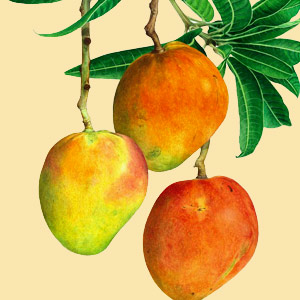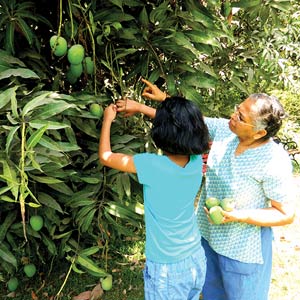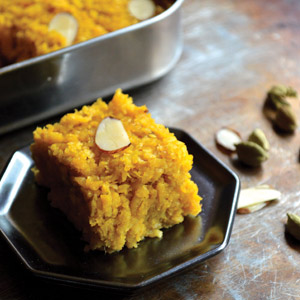Mango Heaven

Those of us who spent our formative years in India, or in a similar warm tropical climate, have fond memories tied to the mango tree: be it one growing near our home or one whose dark branches arch expectantly over a neighbor’s fence, tempting us with its luscious emerald fruits. Our lives seem incomplete without the feeling of sitting under the cool shade of its dense foliage in the heat of the day, taking a bechki (slingshot) to steal a fruit, biting into a tart raw mango wedge smothered in spices, or the sensation on our teeth and gums after having sucked on the mango seed until it looked like a hairy old sage.
In cities across India, mango varieties like Hapus (Alphonso), Kesar, Dasheri, Payri, Langra, Totapuri, etc. become available in summer, and sellers spill into streets touting their wares. The traffic din is replaced by the loud bellowing of cart-vendors or sellers carrying crates of mangoes on their heads. The obsession with this luscious tropical golden fruit is revived for one more season.
Many women spend days collecting recipes, planning communal cooking sessions, agreeing to swap jars of the finished treats, gathering later in kitchens, courtyards and rooftops, transforming the varieties of fruits and their pulp into large jars of savory preserves (acchar), marmalade-like sweet preserves (murabba or choonda), cooking up trays of luscious desserts (halwa, sheera, burfi), whisking together gallons of drinks (lassi, panna or aamras), or creating candy, fruit bars, ice cream and more. The results are well worth their weight in gold and bind their makers in lifelong threads of friendship. My mother and her closest friend, Bhanu Aunty, may not get around to catching up during the year, but come mango season, and they are chatting up a storm!
Due to USDA standards, fruits lack their signature heady caramel aroma, are raw (more suitable for shipping), cold from storage, and lack the warmth that comes from being just fished out from under a blanket of hay. To honor our memories, while trying to give our children the taste of this golden fruit, we purchase mangoes, watch them ripen and hope for the best.
Although mangoes come to markets in late spring to early summer, every season of the year is marked as a preparation of their arrival: watching the sweet fragrant blossoms form in late winter and spring, or the post-mango longing or gloom during the monsoons or fall months.
Alas, for Indian-Americans, our mango pickings are comparatively slim. Sometimes one finds Ataulfo, Kent, Champagne, and Mexican mangoes, and local ethnic stores or online retailers such as Melissa’s Produce may even carry Alphonso. Due to USDA standards, fruits lack their signature heady caramel aroma, are raw (more suitable for shipping), cold from storage, and lack the warmth that comes from being just fished out from under a blanket of hay. To honor our memories, while trying to give our children the taste of this golden fruit, we purchase mangoes, watch them ripen and hope for the best. Sometimes we get really lucky, returning to the seller hoping that the next batch is good. We want our homes to be fragrant with the aroma of ripening mangoes, we yearn to bite into a perfectly ripe wedge, or scoop up aamras with poori, gleefully becoming children again as we let it trickle down our arms, devouring every last speck from our plates and bowls.

My first memories of mango trees can be traced to the Godrej Colony at Vikhroli (Mumbai), where my maternal grandmother lived. Mango trees were planted as street trees and in the community park, and we kids would spend many afternoons with our slingshots, aiming for the high branches to get a few golf ball sized juicy fruits. When my parents bought their paddy fields and mango orchard in the late 1970’s at Alibag, we gained nearly 50 Alphonso trees, with fruits weighing more than a pound each! We ate what we could, made ice cream on a hand-cranked ice cream maker, and bottled the rest.
The first time my daughter went to the farm, in 2004, she was six months old. My mother gave her a big partially peeled mango. It seemed like a rite of passage, a christening, as my baby was gleefully and quickly covered in its delicious sweet pulp. Although we’ve made many trips since, when she returned at the age of 9, we were lucky that the fruit was still being harvested.
| Nandita's daughter gets a lesson on mangoes. |
A fantastic quick and easy recipe, technically it should keep in the refrigerator for up to a week. However, because it is so deliciously addictive, I can’t guarantee that it will last! This burfi is very well suited as a lunch box treat. And if you are heading to India this summer, I hope you get to create memories under a mango tree.
 Coconut Mango Halwa / Burfi / Fudge
Coconut Mango Halwa / Burfi / Fudge
Makes: Twelve-fourteen servings; approx. 200 calories ea.
Diet: Vegan adaptable, Jain, Ritual friendly, Gluten-free
Prep Time: <30 minutes
Cook Time, Ease: <25 minutes, Easy
INGREDIENTS
1/4 cup ghee
2 cups freshly grated coconut, or unsweetened frozen grated coconut
1 cup or less sugar
1-2 cups of peeled and diced fresh mango (Alphonso preferred), pureed; or one 16-oz can of mango pulp
1/2 tsp green cardamom seeds, finely crushed
METHOD
Grease a shallow, square/rectangular glass cake pan with 1 tsp ghee and set aside.
Heat the remaining ghee in a deep nonstick pan. Sauté the fresh coconut in the hot ghee until it sizzles and appears lightly toasted. Add half the sugar and let it melt and be absorbed by the coconut. At first the mixture will appear dry, but as the sugar is absorbed, it will take on a moist appearance. Gradually add the mango pulp to sweeten, adding no more than . cup at a time. Stir and allow the mixture to thicken in between additions. Stir continuously to avoid burning. Check for sweetness/tartness. Adjust with sugar/mango pulp as per taste. Cook for 10 minutes or less, on medium low heat until the mixture is doughy and sticky, and begins to leave the side of the pan. This is also to ensure that there is very little moisture in the mix. Sprinkle in the cardamom powder when the mixture is almost done and stir to ensure it is completely mixed.
Pour the hot fudge into the prepared pan and flatten quickly with the back of a spoon before it cools. As it cools, it will get sticky and be more difficult to spread around or score. Score the fudge and cool for 1-2 hours until the fudge sets semi-firm. Cut into squares and set to chill. Enjoy!
Optional: The fudge is nut free, but pistachios or slivered almonds boost its nutritional value. Sprinkle them on the fudge just before scoring.
Nandita Godbole is an indie author of two cookbooks: A Dozen Ways to Celebrate (2014), about creating elaborate Indian-themed dinner parties, and Crack the Code: Cook Any Indian Meal with Confidence (2016), about the fundamental principles behind Indian cooking, learned from her grandfather. Under her brand Curry Cravings™, she offers private cooking lessons for learners of all ages, especially novices, and blogs at: www.currycravingskitchen.com
Enjoyed reading Khabar magazine? Subscribe to Khabar and get a full digital copy of this Indian-American community magazine.
blog comments powered by Disqus












